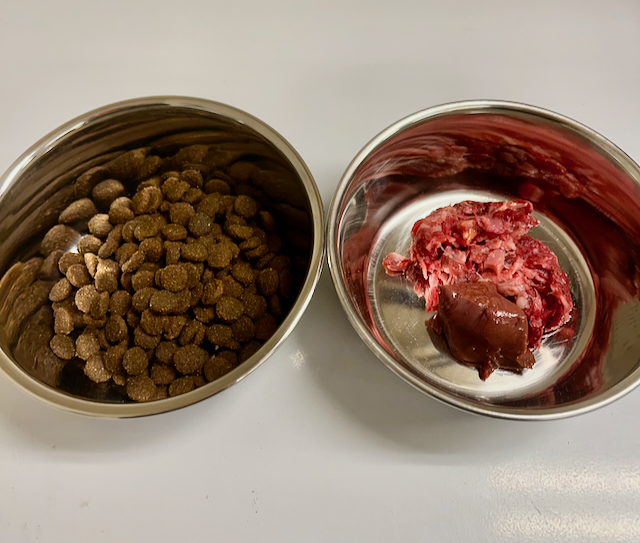We just finished up with Thanksgiving and are now full steam ahead into the holiday season. If your household is anything like mine, you probably include your furry friends in the seasonal traditions. Those traditions might include something as simple as walking together to enjoy the sparkling lights, or a special gift under the tree for Fido. Perhaps it’s a bit more complex like posing for photos with Santa while wearing those reindeer antlers!
Whatever the tradition is, my guess is that your pup’s favorite part of the holiday may be receiving a bit of turkey or other treats from the dinner table.
I have to admit, my dogs don’t really take part in that tradition..not because they don’t get all sorts of good food from me, but because real food isn’t just a seasonal treat.
My dogs eat “human food” all the time. Those words are in quotations because the idea of “human” versus “dog” food is how we’ve been brainwashed to think about feeding our dogs for many decades.
It is pretty silly when you think about it. We should always aspire to feed our dogs healthy, high quality food, rather than something artificially categorized as meant only for canines.
Many foods routinely consumed by humans fall into the category of healthy, high quality food for dogs. They include meats, vegetables, fruits, and healthy fats. Of course dogs, just like humans, can have preferences. Take a look at the food tasting test my friends at Volhard Dog Nutrition did, to see how diverse some palettes are.
While some dogs will turn their nose up at veggies, you will be hard pressed to find a dog that won’t eat meat. Why do you suppose that is?
Well, let me tell you—because dogs have a carnivorous bias. They are not obligate carnivores, but when meat is available, that is what they will choose for their primary food source.
So which one of these actually looks like meat to you?

It is a pretty straight forward answer. The facts are simple, ingredients used to create “dog food” get ultra processed to the point that they are no longer identifiable as food. Effective marketing has indoctrinated us with the idea that hard, brown nuggets are the only choice for our dogs. We have forgotten how dogs have existed for thousands of years before James Spratt’s Patent Dog Biscuits came on the scene in the mid 1800’s. By the time Spratt’s was sold to General Mills in the 1950’s, we’d been converted! The belief system was that little brown nuggets = dog food. Anything from the table was considered for human consumption only.
Despite the marketing that led us astray, dry dog food remains highly convenient. And there are some brands that do a decent job creating a quality product. That said, it is still a hard, dry nugget and adding fresh foods to your dog’s diet will enhance the quality. Fresh foods will provide variety and biodiversity to your dog’s diet.
Here are some good choices to consider:
- Sardines or other fatty fish (packed in water, not oil)
- Raw (or lightly cooked) muscle and organ meat
- Goats milk kefir, cottage cheese, or yogurt (Plain, not flavored)
- Raw or lightly scrambled eggs
- Pureed or steamed vegetables
Healthy “human” food. Add some to your dog’s bowl…your dog will be healthier and happier for it.
I can vouch for feeding dogs sardines. My dogs love sardines and every dog that I treat to a sardine seems to love them too. Thanks for sharing some good info on a somewhat nuanced topic for dog owners.